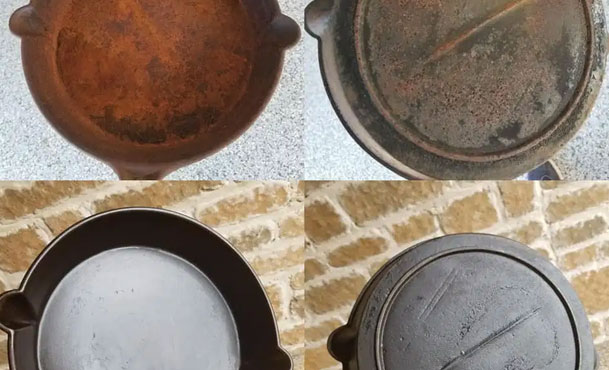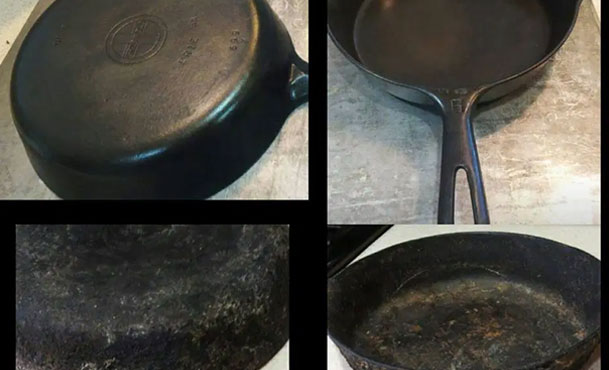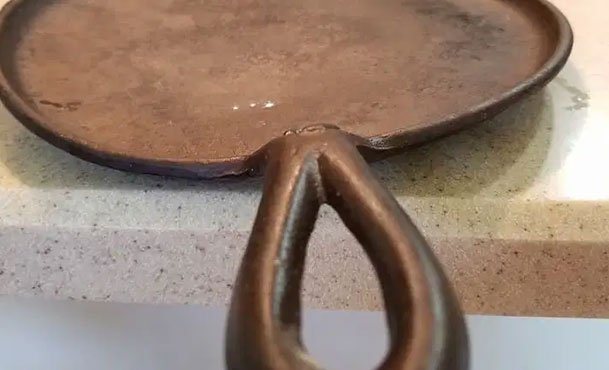
In the last few blogs I have written about different ways to restore cast iron. Sadly, these two ways are never mentioned in magazines that tell you "the best" way to restore your cast iron. Some magazines support the self-cleaning oven method, which I'm 100 percent opposed to. I have tried the self-cleaning route before, and I wasn't happy that I had to replace a part on my oven because the oven got too hot and burned the ignitor. I was out $120! I was determined that there had to be another way to restore cast iron, without damaging the cast iron. I joined Facebook cast iron community groups and found the lye and electrolysis tank methods.
There are two other ways in cleaning cast iron, but not supported. In some groups they're frowned upon. One can certainly get you banned in a cast iron community group. Believe me, I was close to getting banned because I had no clue about how to restore cast iron, and the question I asked started a frenzy.
Fire tossing is the big no-no from cast iron groups. That word will get you banned from a group. I want to take the time to briefly explain why these two methods aren't the best ways in cleaning cast iron
The self-cleaning oven cycle is one of the most common ways to restore a cast iron skillet. This approach is mentioned in talk shows, magazines, YouTube, and culinary experts.
I'm against this approach because it's not good on your oven and the hazards that go along with burning off cast iron build-up and residue. When I first tried this approach, I used a cast iron piece that was extremely dirty and layers of build-up. This was the first time I had used the self-cleaning cycle method in restoring cast iron. I had the mindset of, "If it's good enough on YouTube, it's good enough for me." I was wrong and I got really scared at what happened during this restoration process.
While the self-cleaning cycle was on, I noticed the house was getting extremely smokie. The smoke detectors went off and I looked in my oven and noticed a small fire had erupted in my oven. The crud build-up from the skillet started to produce a lot of ash. The ash ended up sparking a small fire in the oven. I turned off the self-cleaning cycle and watched the oven very closely as the fire started to burn out. That sent enough panic through my veins, and I never attempted that method ever again! About three days later, my ignitor wasn't working and had to replace my ignitor on my oven. I talked to the man who was a professional in fixing appliances and he informed me that the self-cleaning cycle button is more of a sales pitch for an oven, than about safety. When there is enough build-up in the oven, it can release carbon monoxide into your home. That was all I needed to hear that day, the self-cleaning cycle will never be used again at my home.

Also, the self-cleaning cycle can reach well above 880 degrees. This is NOT good on your cast iron. I've heard horror stories of cast iron breaking in half and shooting out of the oven, shattering the glass door. That's an 880-degree bullet shooting out of your oven! I don't want to fathom the damage an 880-degree skillet can do to an adult or even a child. The cons were greater than the pros. Especially, losing an oven and cast iron all in the same day.
The other method is extremely controversial. I've actually had to back off these conversations on Facebook because they can turn into some pretty nasty conversations.
The fire tossing method was used in the earlier days (19th century) to remove residue build-up. After the skillet was removed from the dying fire, they would season the skillet in animal fat. Today we know of better ways to remove residue build-up and we have also discovered that a lot of the cast iron that was fire tossed became destroyed.
A fire can get pretty hot. Most commonly between 600 to 1,100 degrees. The greater the fire, the temperature rises. At 2,000 degrees iron can start to bend. Cast iron is a wonderful conductor of heat. Once heated up, iron can retain that heat for a long time. However, when cast iron is exposed to fire, the heat can vary in temperature and change suddenly. That can easily destroy your cast iron. Heat causes expansion and the kinetic energy causes atoms and molecules to move around more. When the cooling process starts, cast iron will contract. Thus causing it to warp. Fires are NOT regulated in temperature, which makes this extremely dangerous in restoring cast iron. Not only does fire tossing cause your cast iron to bend, but it can also leave burn marks. Burn marks on cast iron can be rather easy to detect. The texture is very rough and they show a bright pink or purple color. Also, fires can break cast iron in half. Many of the older pieces I have restored were bright purple, rough, warped, and cracked. Sadly, some of those pieces were HIGHLY marked as collectibles. When collectibles are badly damaged, the value is no longer there.

Burn markings from fire tossed cast iron are very hard to season over because the fire damaged the most critical part of the cast iron skillet. Cast iron was made with a surface that allows oil to carbonize over the surface of the skillet, creating a non-stick surface. Without that surface, you have a harder time creating a non-stick surface.

Today, we understand the chemistry of metals better, and what happens during the heating process. Cast iron is a wonderful heat conductor, but very poorly at heating up evenly. This is why cast iron must be heated up slowly, because the bottom of the cast iron skillet can pop out causing a piece of cast iron to spin rather than sit flat. Another reason why you should NEVER lay cast iron directly on to a fire.
When I'm restoring a customer's antique cast iron or purchasing antique cast iron, I always take my time to feel around the pieces because of fire tossing. Many of the antique pieces of cast iron are damaged because of the fire tossing method.
I have found rusted pieces of cast iron and restored them. Depending on the collectors market, cast iron collectible can be valued in the hundreds. If I had thrown the cast iron in a fire or a stove, I could have easily destroyed that piece and the value.
Restoring cast iron is an art and with the right patience, anyone can bring a very old piece back to life.
